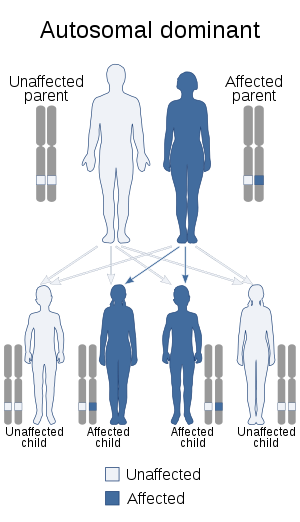Upington disease
Upington disease, is an extremely rare[3] autosomal dominant malformation disorder. It has only one published source claiming its existence in three generations of one family from South Africa.[4]
| Upington disease | |
|---|---|
| Other names | Perthes-like hip disease, Enchondromata, Ecchondromata, and Familial dyschondroplasia,[1][2] |
 | |
| Upington disease has an autosomal dominant pattern of inheritance. | |
| Specialty | Rheumatology |
Presentation
The disease is characterized by Perthes-like pelvic anomalies (premature closure of the capital femoral epiphyses and widened femoral necks with flattened femoral heads), enchondromata and ecchondromata.
Genetics
Upington disease is inherited in an autosomal dominant manner.[4][5] This means the defective gene is located on an autosome, and one copy of the defective gene is sufficient to cause the disorder, when inherited from a parent who has the disorder.
Management
Eponym
The name Upington refers to the city in the Northern Cape Province, South Africa from where the family originates.[1]
References
- Online Mendelian Inheritance in Man (OMIM): 191520
- "Upington disease | Disease | Living With | Genetic and Rare Diseases Information Center (GARD) – an NCATS Program". rarediseases.info.nih.gov. Retrieved 2016-03-01.
- Disease ID 5421 at NIH's Office of Rare Diseases
- Schweitzer G, Jones B, Timme A (1971). "Upington disease: a familial dyschondroplasia". S. Afr. Med. J. 45 (36): 994–1000. PMID 5316541.
- ORPHANET - About rare diseases - About orphan drugs
External links
| Classification | |
|---|---|
| External resources |